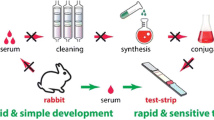Abstract
Membrane-based dot immunoassays are now widely used in almost every branch of biology and medicine. However, the quality of the immobilized antigen or antibody spots on the membranes was found to be highly operator-dependent and spotting by conventional methods often leads to heterogeneous spot morphologies and deposition inconsistencies. To circumvent these problems, a spotting method has been developed which is based on focussed absorption of an applied antibody solution through an aqueous network of capillary channels formed between the membrane and a wetted absorbent body. The method does not require any equipment for creating vacuum and according to assay requirements highly homogeneous spots of uniform size, in the range of 0.8- to 9-mm diameter, can be obtained by varying the volume of the applied antibody solution. Spot intensities were sufficiently high even at high antibody dilutions. Immobilization of anti-ochratoxin A (anti-OA) antibody by this method gave 2-fold increased sensitivity in a competitive assay of the toxin compared to conventional spotting methods. The calculated CV of the colour intensity for spots of different sizes (0.8 to 9 mm) was between 4.5 and 1%. Application of this spotting technique has been demonstrated for detection of OA in wine and coffee samples with the elimination of matrix interferences in the same immunoassay system. This was achieved by selective removal of nonspecific interfering substances from the sample extract during the assay. The detection limit of OA in wine (1 μg L−1) and coffee (2.5 μg kg−1) obtained by the present new method is superior to values reported recently. Thus, the present new method will be highly useful for improved performance of membrane-based immunoassays in almost every branch of biology and medicine.







Similar content being viewed by others
References
Xu Y, Bao G (2003) Anal Chem 75:5345–5351
Sibanda L, De Saeger S, Barna-Vetro I, Van Peteghem C (2002) J Agric Food Chem 50:6964–6967
Pal A, Dhar TK (2004) Anal Chem 76:98–104
Pal A, Acharya D, Saha D, Roy D, Dhar TK (2005) J Food Prot 68:2169–2177
Wang S, Zhang C, Zhang Y (2005) Anal Chim Acta 535:219–225
De Sagar S, Van Peteghem C (1996) Appl Environ Microbiol 62:1880–1884
Bhattacharya R, Bhattacharya D, Dhar TK (1999) J Immunol Methods 227:31–39
Ijsselmuiden OE, Herbrink P, Meddens MJM, Tank B, Stolz E, Van Eijk RVW (1989) J Immunol Methods 119:35–43
Morais S, Maquieira A, Puchades R (1999) Anal Chem 71:1905–1909
Bio-Rad Laboratories, Bio-Dot Microfiltration Apparatus, Instruction Manual, No170-6545
Beardall JM, Miller JD (1994) In: Miller JD, Trenholomn HL (eds) Grain compounds other than aflatoxin. Eagan Press, St Paul, MN, pp 487–539
Studer-Rohr I, Dietrich DR, Schlatter J, Schlatter C (1995) Food Chem Toxicol 33:341–355
Pittet A, Royer D (2002) J Agric Food Chem 50:243–247
Gonzalez-Penas E, Leache C, Viscarret M, Perez de Obanos A, Araguas C, Lopez de Cerain A (2004) J Chromatogr A 1025:163–168
Yu F, Chi T, Liu B, Su C (2005) J Agric Food Chem 53:6947–6953
Scott PM (2002) Adv Exp Med Biol 504:117–134
Monaci L, Palmisano F (2004) Anal Bioanal Chem 378:96–103
Visconti A, Pascale M, Centonze G (1999) J Chromatogr A 864:89–101
Habeeb, AFSA (1966) Anal Biochem 14:328–336
Das Sarma J, Duttagupta C, Ali E, Dhar TK (1995) J Immunol Methods 184:1–6
Pittet A, Tornare D, Hugget A, Viani R (1996) J Agric Food Chem 44:3564–3569
Zimmerli B, Dick R (1995) J Chromatogr B 666:85–99
Ngundi MM, Shriver-Lake LC, Moore MH, Lassman ME, Ligler FS, Taitt CR (2005) Anal Chem 77:148–154
Acknowledgement
We thank the Council of Scientific and Industrial Research, Delhi, for a Research Fellowship to D.S.
Author information
Authors and Affiliations
Corresponding author
Rights and permissions
About this article
Cite this article
Saha, D., Acharya, D. & Dhar, T.K. Method for homogeneous spotting of antibodies on membranes: application to the sensitive detection of ochratoxin A. Anal Bioanal Chem 385, 847–854 (2006). https://doi.org/10.1007/s00216-006-0484-4
Received:
Revised:
Accepted:
Published:
Issue Date:
DOI: https://doi.org/10.1007/s00216-006-0484-4




